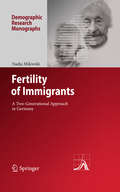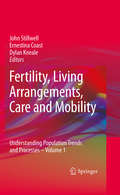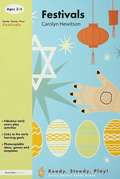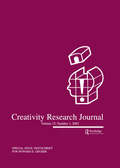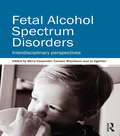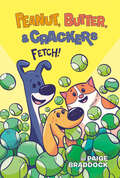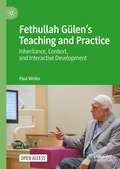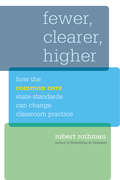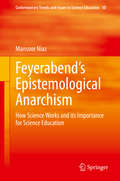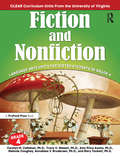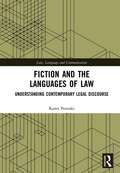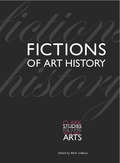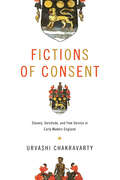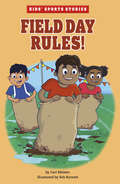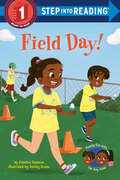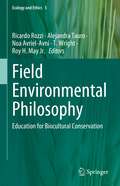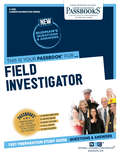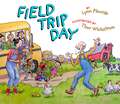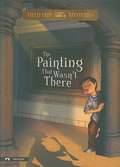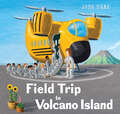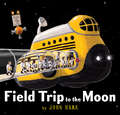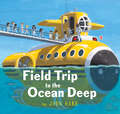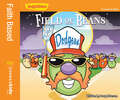- Table View
- List View
Fertility of Immigrants
by Nadja MilewskiThis book examines fertility patterns of post-war labor migrants and their descendants in Germany. It includes an introduction to the post-war migration history of Germany and a thorough review of the international literature on fertility of migrants and cultural sub-groups. The author uses data from the German Socio-economic Panel Study and applies event-history techniques to test a set of competing hypotheses derived from the literature. The analysis finds evidence for the effects of adaptation, socialization and composition, as well as for an interrelation of events. It does not however find evidence for a disruptive influence of migration on childbearing behavior. The book shows the advantages of a longitudinal research design over the conventional cross-sectional approach and sets a new standard for research on the fertility of international migrants and their descendants in western European receiving societies.
Fertility, Living Arrangements, Care and Mobility
by Dylan Kneale Ernestina Coast John StillwellMany parts of the world are experiencing rapid demographic restructuring, resulting in an ageing population with increasingly significant work and care pressures on cohorts less able or willing to provide support. This book examines some of the important trends that have underpinned reductions in fertility, including delayed child-bearing and increased childlessness. It demonstrates how relationships between partners have resulted in new living arrangements with changing attitudes from marriage to co-habitation as the social norm, and it considers the health and well-being for particular at risk groups such as the elderly and stepparents as well as aspects of mobility such as household migration and commuting to school. The book brings together a series of studies that all involve quantitative analyses of secondary data from censuses, surveys or administrative records. The trends and patterns reported provide new and interesting insights into behaviour of the household and the roles of adults and children, and point to questions of critical importance for practitioners and policy makers.
Festivals (Ready, Steady, Play!)
by Carolyn HewitsonFestivals provides an insight into various events that children may, or may not, have in common. It will enhance your understanding of a range of cultural events, provides a range of activities that have meaning for children, and encourages knowledge and understnading of life in a multi-cultural environment.
Festschrift for Howard E. Gruber: A Special Issue of the creativity Research Journal
by Howard E. GruberHoward E. Gruber has changed the domain of creative studies in several ways: by making it more realistic with his systems theory, introducing the idea of "a theory of the individual" and developing a method to this ends, and positioning the domain of creative studies where it can build on the domain of morality. He has opened more than a few eyes to a new domain--moral creativity--and this special issue shows Gruber's influence in this regard. As a result, this first Festschrift of Creativity Research Journal provides readers with unique, novel, and creative ideas.
Fetal Alcohol Spectrum Disorders: Interdisciplinary perspectives
by Barry Carpenter Jo Egerton Carolyn BlackburnFetal alcohol spectrum disorders (FASDs) have emerged as a major phenomenon within the education, health, criminal justice and social care systems of many countries, with current prevalence figures suggesting that one in a hundred children and young people have FASDs. In this publication, academics, professionals and families from around the world have shared expertise and insights on FASDs. Their combined interdisciplinary perspective makes an invaluable contribution to how we understand and address the complex social, educational and health needs associated with this growing group of children and young people. Articulating fundamental knowledge, cutting edge initiatives and emerging trends in FASDs, this book provides an evidence base that will enable services to identify and respond to the need for action on FASDs. It recognises that families – natural, foster or adoptive – are at the heart of this process, and that their rich knowledge base, grounded in their lived experience, is crucial. Any education, social care, criminal justice or health professional working with children and young people with FASDs and their families will find this book a seminal and authoritative resource.
Fetch! (Peanut, Butter, and Crackers #2)
by Paige BraddockPeanut, Butter, and Crackers are back in this hilarious follow-up to Puppy Problems, continuing a graphic novel series for early readers.Floppy-eared Peanut is off to doggy school to learn how to be a good dog! Sure, he's excited, but when he gets separated from Crackers, he quickly realizes that he has to fend for himself. Five minutes in and he's already the new target of the Pint-Sized Pack, the bullies of the Little Dogs group. He knows that Crackers and Butter can't help him, so what use is there in telling them he feels alone without his family?Kids will love Paige Braddock's hilarious follow-up to Puppy Problems. This story of found family and teamwork is sure to strike a chord with young readers everywhere.
Fetch, Cat. Fetch!
by Charles GhignaFetch, Cat. Fetch! is an endearing message of patience and love mixed with a big dose of humor. A winning combination when dealing with pets … and people! Author Charles Ghigna—Father Goose®—masterfully encourages young children to build reading comprehension skills and to gain confidence in this comical look at a special bond between a girl and her beloved cat. This beginning reader, through simple language and short sentences, captures the laughter and joy of watching a sweet, patient child trying to teach her cat to do tricks. The lovable, stubborn, lazy pet cat, on the other hand, just wants to nap all day and refuses her attempts to play fetch, or to sit, shake, roll over, or do any other tricks that a dog would do. Subtle humor, sight words, and lots of repetition make this a unique and fun first independent reading book. And just when the reader thinks the cat will finally get his nap, a clever twist of irony will have children laughing hysterically. The girl finally gives up and asks the cat to stay, and that’s when he finally gets up—and runs away!
Fethullah Gülen’s Teaching and Practice: Inheritance, Context, and Interactive Development
by Paul WellerThis is the first book of its kind about the Turkish Muslim scholar, Fethullah Gülen, since the July 2016 events in Turkey, the trauma experienced by Gülen, and the disruption to initiatives inspired by his teaching, known as Hizmet. Drawing on primary interviews with Gülen and Hizmet participants and a literature review, this Open Access book locates the clear origins of Gülen’s teaching in the Qur’an and Sunnah in dynamic engagement with their geographical, temporal and existential reception, translation, and onward communication. It argues that as Hizmet cannot be understood apart from Gülen and his teaching, Gülen and his teaching cannot be understood apart from Hizmet, while exploring the heritage of both. A more geographically focused case study is set out in author Paul Weller’s Hizmet in Transitions: European Developments of a Turkish Muslim-Inspired Movement, also published by Palgrave Macmillan (2022).
Fewer, Clearer, Higher: How the Common Core State Standards Can Change Classroom Practice
by Robert RothmanIn clear and concise language, veteran education writer Robert Rothman identifies nine instructional "shifts" encouraged by the new Common Core State Standards and provides examples of how teachers and school districts are overcoming challenges in implementation. He presents the research and rationale behind each change and provides examples of teachers making the shifts as well as sample test questions that could be used to gauge student progress in the future. Rothman also addresses major challenges that are emerging as districts and schools move to implement the standards and highlights the ways leading school districts are working to overcome them.Fewer, Clearer, Higher--the mantra adopted by the writers of the Common Core to emphasize the difference between existing state standards and the new ones needed to truly prepare all students for college or careers--is an indispensable guide for educators and anyone else seeking a better understanding of this major new development in education policy.
Fewer, Clearer, Higher: How the Common Core State Standards Can Change Classroom Practice (HEL Impact Series)
by Robert RothmanIn clear and concise language, veteran education writer Robert Rothman identifies nine instructional &“shifts&” encouraged by the new Common Core State Standards and provides examples of how teachers and school districts are overcoming challenges in implementation. He presents the research and rationale behind each change and provides examples of teachers making the shifts as well as sample test questions that could be used to gauge student progress in the future. Rothman also addresses major challenges that are emerging as districts and schools move to implement the standards and highlights the ways leading school districts are working to overcome them.Fewer, Clearer, Higher—the mantra adopted by the writers of the Common Core to emphasize the difference between existing state standards and the new ones needed to truly prepare all students for college or careers—is an indispensable guide for educators and anyone else seeking a better understanding of this major new development in education policy.
Feyerabend’s Epistemological Anarchism: How Science Works and its Importance for Science Education (Contemporary Trends and Issues in Science Education #50)
by Mansoor NiazThis book argues that the traditional image of Feyerabend is erroneous and that, contrary to common belief, he was a great admirer of science. It shows how Feyerabend presented a vision of science that represented how science really works. Besides giving a theoretical framework based on Feyerabend´s philosophy of science, the book offers criteria that can help readers to evaluate and understand research reported in important international science education journals, with respect to Feyerabend’s epistemological anarchism. The book includes an evaluation of general chemistry and physics textbooks. Most science curricula and textbooks provide the following advice to students: Do not allow theories in contradiction with observations, and all scientific theories must be formulated inductively based on experimental facts. Feyerabend questioned this widely prevalent premise of science education in most parts of the world, and in contrast gave the following advice: Scientists can accept a hypothesis despite experimental evidence to the contrary and scientific theories are not always consistent with all the experimental data. No wonder Feyerabend became a controversial philosopher and was considered to be against rationalism and anti-science. Recent research in philosophy of science, however, has shown that most of Feyerabend´s philosophical ideas are in agreement with recent trends in the 21st century. Of the 120 articles from science education journals, evaluated in this book only 9% recognized that Feyerabend was presenting a plurality of perspectives based on how science really works. Furthermore, it has been shown that Feyerabend could even be considered as a perspectival realist. Among other aspects, Feyerabend emphasized that in order to look for breakthroughs in science one does not have to be complacent about the truth of the theories but rather has to look for opportunities to “break rules” or “violate categories.” Mansoor Niaz carefully analyses references to Feyerabend in the literature and displays the importance of Feyerabend’s philosophy in analyzing, historical episodes. Niaz shows through this remarkable book a deep understanding to the essence of science. - Calvin Kalman, Concordia University, Canada In this book Mansoor Niaz explores the antecedents, context and features of Feyerabend’s work and offers a more-nuanced understanding, then reviews and considers its reception in the science education and philosophy of science literature. This is a valuable contribution to scholarship about Feyerabend, with the potential to inform further research as well as science education practice.- David Geelan, Griffith University, Australia
Fiction and Nonfiction: Language Arts Units for Gifted Students in Grade 4
by Carolyn M. Callahan Tracy C. MissettThe CLEAR curriculum, developed by University of Virginia's National Research Center on the Gifted and Talented, is an evidence-based teaching model that emphasizes Challenge Leading to Engagement, Achievement, and Results. In Fiction and Nonfiction: Language Arts Units for Gifted Students in Grade 4, students will read and analyze short stories and write their own short story in the fiction unit. In the nonfiction unit, students will study nonfiction (and creative nonfiction) texts to examine how writers use many of the same devices to tell nonfiction stories. Students will read a variety of texts and will write their own memoirs. These units focus on critical literacy skills, including reading diverse content, understanding texts as reflections of culture, and finding bias in fiction and nonfiction.Grade 4
Fiction and the Languages of Law: Understanding Contemporary Legal Discourse (Law, Language and Communication)
by Karen PetroskiContemporary legal reasoning has more in common with fictional discourse than we tend to realize. Through an examination of the U.S. Supreme Court’s written output during a recent landmark term, this book exposes many of the parallels between these two special kinds of language use. Focusing on linguistic and rhetorical patterns in the dozens of reasoned opinions issued by the Court between October 2014 and June 2015, the book takes nonlawyer readers on a lively tour of contemporary American legal reasoning and acquaints legal readers with some surprising features of their own thinking and writing habits. It analyzes cases addressing a huge variety of issues, ranging from the rights of drivers stopped by the police to the decision-making processes of the Environmental Protection Agency—as well as the term’s best-known case, which recognized a constitutional right to marriage for same-sex as well as different-sex couples. Fiction and the Languages of Law reframes a number of long-running legal debates, identifies other related paradoxes within legal discourse, and traces them all to common sources: judges’ and lawyers’ habit of alternating unselfconsciously between two different attitudes toward the language they use, and a set of professional biases that tends to prevent scrutiny of that habit.
Fictions of Art History
by Joanna Scott Alexander Nemerov Marianna Torgovnick Cole Swensen Marina Warner Caroline Vout Michael Hatt Paul Barolsky Gloria Kury Maria H. Loh Ralph Lieberman Mark Ledbury Thomas CrowFictions of Art History, the most recent addition to the Clark Studies in the Visual Arts series, addresses art history's complex relationships with fiction, poetry, and creative writing. Inspired by a 2010 conference, the volume examines art historians' viewing practices and modes of writing. How, the contributors ask, are we to unravel the supposed facts of history from the fictions constructed in works of art? How do art historians employ or resist devices of fiction, and what are the effects of those choices on the reader? In styles by turns witty, elliptical, and plain-speaking, the essays in Fictions of Art History are fascinating and provocative critical interventions in art history.
Fictions of Consent: Slavery, Servitude, and Free Service in Early Modern England (RaceB4Race: Critical Race Studies of the Premodern)
by Urvashi ChakravartyIn Fictions of Consent Urvashi Chakravarty excavates the ideologies of slavery that took root in early modern England in the period that preceded the development of an organized trade in enslaved persons.Despite the persistent fiction that England was innocent of racialized slavery, Chakravarty argues that we must hold early modern England—and its narratives of exceptional and essential freedom—to account for the frameworks of slavery that it paradoxically but strategically engendered. Slavery was not a foreign or faraway phenomenon, she demonstrates; rather, the ideologies of slavery were seeded in the quotidian spaces of English life and in the everyday contexts of England's service society, from the family to the household, in the theater and, especially, the grammar school classroom, where the legacies of classical slavery and race were inherited and negotiated. The English conscripted the Roman freedman's figurative "stain of slavery" to register an immutable sign of bondage and to secure slavery to epidermal difference, even as early modern frameworks of "volitional service" provided the strategies for later fictions of "happy slavery" in the Atlantic world. Early modern texts presage the heritability of slavery in early America, reveal the embeddedness of slavery within the family, and illuminate the ways in which bloodlines of descent underwrite the racialized futures of enslavement.Fictions of Consent intervenes in a number of areas including early modern literary and cultural studies, premodern critical race studies, the reception of classical antiquity, and the histories of law, education, and labor to uncover the conceptual genealogies of slavery and servitude and to reveal the everyday sites where the foundations of racialized slavery were laid. Although early modern England claimed to have "too pure an Air for Slaves to breathe in," Chakravarty reveals slavery was a quintessentially English phenomenon.
Field Day Rules! (Kids' Sports Stories)
by Cari MeisterIt's field day at Raj's school, and he and his classmates should be thrilled. But it's raining, so all the games and races have been moved inside to the gym. It's not the awesome outdoor sports day the kids had in mind—until they find a way to turn soggy into sunny!
Field Day! (Step into Reading)
by Candice RansomGet ready for some outdoor fun in this Step 1 book that's perfect for readers ages 4-6! Join the Day kids as they gear up for field day at school.What's more fun than field day? The Day kids are so excited! They gobble their breakfast and race to the bus. So many fun things are waiting for them! Spoon-and-egg race! Face-painting! Kickball! A bouncy castle! Brother and sister can't wait! Step 1 Readers feature big type and easy words. Rhymes and rhythmic text paired with picture clues help children decode the story. For children who know the alphabet and are eager to begin reading.A day with family is always a great day! Read all the DAY family books:Apple Picking Day!Pumpkin Day!Garden Day!Beach Day!School Day!
Field Environmental Philosophy: Education for Biocultural Conservation (Ecology and Ethics #5)
by Ricardo Rozzi Roy H. May T. Wright Alejandra Tauro Noa Avriel-AvniThis fifth volume in the Ecology and Ethics series integrates key concepts of the previous four volumes by addressing biocultural conservation through novel educational methods. In Field Environmental Philosophy (FEP), the authors undertake two complementary tasks. First, they address a problematic facet of education as an indirect driver of a global change and biocultural homogenization. Second, they contribute to solve the former problems by introducing the FEP method as well as other educational approaches from around the world that value and foster conservation of biological and cultural diversity. A particular emphasis is therefore on the integration of sciences, arts, humanities, and ethics into educational practices that involve the participation of local communities with their diverse forms of ecological knowledge and practices. The book is divided into four parts. Part I introduces FEP concepts and practices that involve a 4-step cycle of transdisciplinary research, poetic communication through composition of metaphors, design of field activities guided with an ecological and ethical orientation, and participation in biocultural conservation activities. Part II exposes problems as well as solutions in formal education (from preschool to higher education) and non-formal education to respect biocultural diversity. Parts III & IV provide case studies developed at long-term socio-ecological research (LTSER) sites, botanical gardens, and other platforms for non-formal education that contribute to biocultural conservation.This book supports a paradigm shift addressing still understudied indirect drivers of global change to foster the conservation of biological and cultural diversity. It is a valuable asset for scientists and practitioners in science and humanities education.
Field Investigator: Passbooks Study Guide (Career Examination Series)
by National Learning CorporationThe Field Investigator Passbook® prepares you for your test by allowing you to take practice exams in the subjects you need to study. It provides hundreds of questions and answers in the areas that will likely be covered on your upcoming exam.
Field Trip Day
by Lynn PlourdeToday is Field Trip Day at school, and everyone in Mrs. Shepherd?s class is excited to visit Fandangle?s Farm, especially Juan, who loves to explore. But Juan just might be too good at exploring, and Mrs. Shepherd and the chaperones have trouble keeping track of him! This sixth story about the silly students in Mrs. Shepherd?s class will have readers laughing and learning as Juan?s discoveries lead to new teaching opportunities for Farmer Fandangle and Mrs. Shepherd.
Field Trip Mysteries: The Painting That Wasn't There
by Steve BrezenoffJames "Gum" Shoo's art class heads to the museum. They've been learning about forged art, but they never expected to find a fake in the gallery! Only Gum and his gumshoe friends will be able to solve this museum caper.
Field Trip to Volcano Island (Field Trip Adventures)
by John HareA wordless picture book adventure takes a group of students to visit a thrilling volcanic island. Perfect for fans of Field Trip to the Moon, Field Trip to the Ocean Deep, and field trips in general!John Hare&’s rich, atmospheric art invites all children to imagine themselves in the story – a story full of surprises and adorable new friends.The same students we met in Field Trip to the Moon and Field Trip to the Ocean Deep travel to a volcano island on a yellow school bus helicopter. When they get there, one student picks flowers as they hike to the top and then accidentally slips down a crater and can&’t get out.The student isn&’t too worried--especially when he meets a lava monster and its children who are fascinated by the flowers. But when they touch them, they burn beyond recognition so the student teaches them how to make a vase using lava from a lava pit, fills it with water from a canteen, and they all sit back to enjoy the flower arrangement until help arrives and rescues the student.A Junior Library Guild Gold Standard SelectionPraise for previous books by John Hare Field Trip to the MoonA Junior Library Guild Gold Standard SelectionA School Library Journal Best Book of the Year A Horn Book Best Book of the Year A Bank Street Best Book of the Year - Outstanding Merit Field Trip to the Ocean DeepA Junior Library Guild Gold Standard Selection"Fans of the previous field-trip story will be pleased to see allusions to it, including character cameos and a glimpse of the space bus."—The Horn Book
Field Trip to the Moon (Field Trip Adventures)
by John HareIt's field trip day, and students are excited to travel on their yellow spaceship bus from their space station to the moon in this wordless picture book.An ALA Notable Children's BookA Golden Duck Notable Picture BookClimb aboard the spaceship bus for a fantastic field trip adventure to the moon! Once their bright yellow ship lands, students debark and set out with their teacher to explore. They jump over trenches and see craters and mountains on the moon's surface and even Earth in the faraway distance. But when one student takes a break to draw some pictures and falls asleep, they wake up to discover that the rest of the class and the spaceship are gone. How the student passes the time waiting to be rescued makes for a funny and unexpected adventure that will enchant children all over the galaxy.With rich atmospheric art, John Hare's wordless picture book invites children to imagine themselves in the story--a story full of surprises including some friendly space creatures. A perfect complement to discussions and lessons on the moon landing.Don't miss Field Trip to the Ocean Deep, another wordless adventure! Recipient of the Pied Piper Literary PrizeAn ILA-CBC Children's Choice!A Pennsylvania Center for the Book Baker's Dozen Selection!A School Library Journal Best Book of the YearA Horn Book Best Book of the YearA Bank Street Best Book of the Year - Outstanding Merit
Field Trip to the Ocean Deep (Field Trip Adventures)
by John HareCome join the fun as students take a submarine bus on a field trip to explore the ocean deep, in this wordless picture book from the creator of Field Trip to the Moon!Students dressed in deep sea helmets travel to the ocean deep in a yellow school-bus submarine. When they get there, they frolic with fish, chase luminescent squid, and discover an old shipwreck. But when it's time to return to the submarine bus, one student lingers to take a photo of a treasure chest and falls into a deep ravine. Luckily, the child makes an unexpected friend-- a maybe-not-so-extinct sea creature called a Pleiosaur- that's happy to entertain the young explorer until the teacher returns. In his follow-up to Field Trip to the Moon, John Hare's rich, atmospheric art in this wordless picture book invites all children to imagine themselves in the story- a tale full of mysteries, surprises, and adorable aquatic friends. Named a LITA Golden Duck Picture BookA Junior Library Guild Selection
Field of Beans / VeggieTales: A Lesson in Faith (Big Idea Books / VeggieTown Values)
by Doug PetersonJunior Asparagus discovers a lesson in faith as he learns how to rely on God in times of trouble. Junior realizes that he must have faith to be a real winner.
